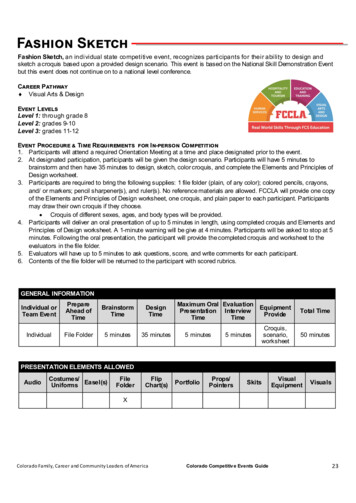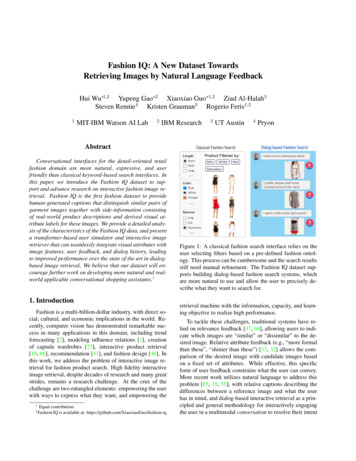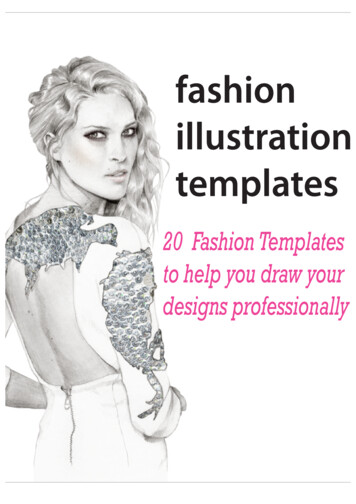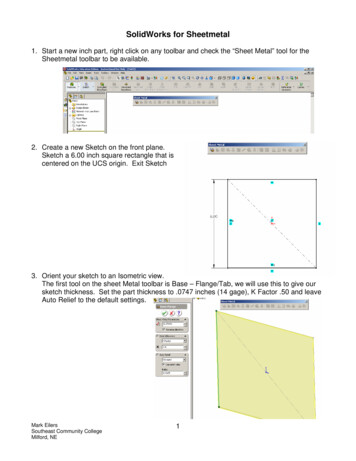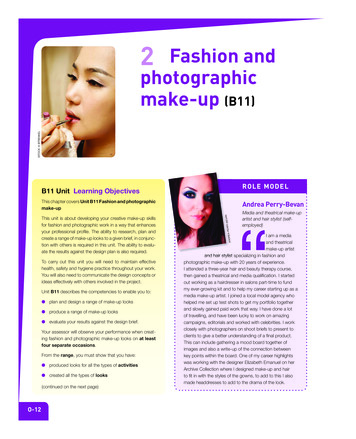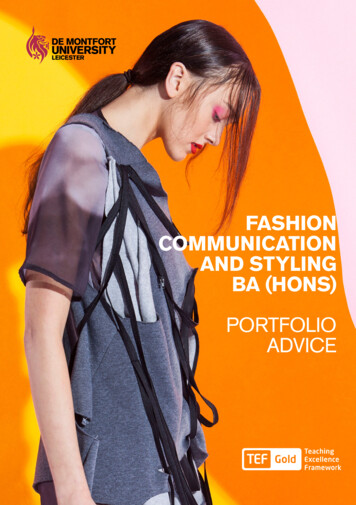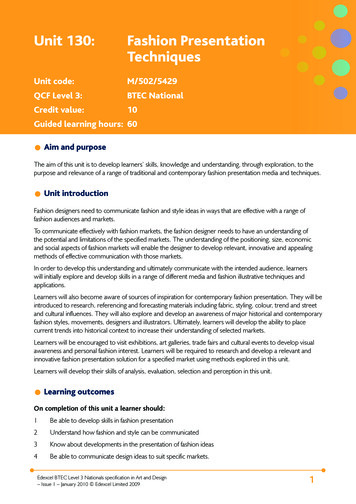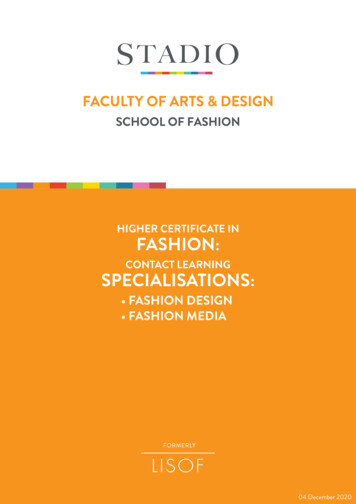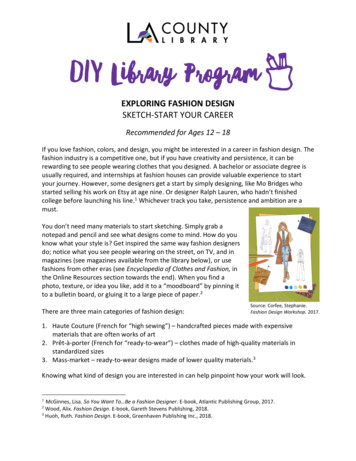
Transcription
-EXPLORING FASHION DESIGNSKETCH-START YOUR CAREERRecommended for Ages 12 – 18If you love fashion, colors, and design, you might be interested in a career in fashion design. Thefashion industry is a competitive one, but if you have creativity and persistence, it can berewarding to see people wearing clothes that you designed. A bachelor or associate degree isusually required, and internships at fashion houses can provide valuable experience to startyour journey. However, some designers get a start by simply designing, like Mo Bridges whostarted selling his work on Etsy at age nine. Or designer Ralph Lauren, who hadn’t finishedcollege before launching his line.1 Whichever track you take, persistence and ambition are amust.You don’t need many materials to start sketching. Simply grab anotepad and pencil and see what designs come to mind. How do youknow what your style is? Get inspired the same way fashion designersdo; notice what you see people wearing on the street, on TV, and inmagazines (see magazines available from the library below), or usefashions from other eras (see Encyclopedia of Clothes and Fashion, inthe Online Resources section towards the end). When you find aphoto, texture, or idea you like, add it to a “moodboard” by pinning itto a bulletin board, or gluing it to a large piece of paper.2There are three main categories of fashion design:Source: Corfee, Stephanie.Fashion Design Workshop. 2017.1. Haute Couture (French for “high sewing”) – handcrafted pieces made with expensivematerials that are often works of art2. Prêt-à-porter (French for “ready-to-wear”) – clothes made of high-quality materials instandardized sizes3. Mass-market – ready-to-wear designs made of lower quality materials.3Knowing what kind of design you are interested in can help pinpoint how your work will look.1McGinnes, Lisa. So You Want To Be a Fashion Designer. E-book, Atlantic Publishing Group, 2017.Wood, Alix. Fashion Design. E-book, Gareth Stevens Publishing, 2018.3Huoh, Ruth. Fashion Design. E-book, Greenhaven Publishing Inc., 2018.2
Questions: Of the three categories of fashion design (Haute Couture, prêt-à-porter, and mass-market),which one could you picture yourself designing?How do you know when an outfit “works” on a person? Do you think there are rules tofashion, or does anything go?ACTIVITYMaterials Needed: Paper Eraser Colored pencils Markers/gel pens Template of model (optional)Using the templates on pages 6 and 7 or by drawing your own models, practice sketching someideas for clothes. Have fun with it and try using different textures and patterns.Use the color wheel below to get a sense for what colors are complementary (those colorsopposite of each other on the wheel), and which are analogous (the colors that are next to eachother on the wheel). Try blending colors using the chart below.Source: Corfee, Stephanie. Fashion Design Workshop. 2017
Now try using a pencil to experiment creating these different textures (For even more, readStephanie Corfee’s Fashion Design Workshop).Smooth – control your pencil to produce an even layer of color.Plaid – use marker for base color and add vertical and horizontal lines with colored pencils ingroups of three.Tweed – use marker for base color and crosshatch with pencils, alternating colors. The key isadding lots of layers. Finish with white gel pen to add definition.
Sequins – use marker for base color and add dots, circles, and starbursts for twinkles.Netting/tulle – choose two or three analogous colors and create a crosshatched pattern withpencil. For a delicate-looking texture, use sharper pencils.Denim – use a gray/green marker for base and colored pencils to add light crosshatching inseveral different shades of blue and gray. Keep pencil sharp so you can make out the “woven”texture.
Shiny (patent leather, satin, etc.) – use a bold marker color and leave some areas of white. Addvertical stripes of darker colors.Layered chiffon – use a light-colored marker for base and build up shading in a vertical patternusing analogous shades. Darken areas around gathers and use white pencil to highlight folds.Polka dots – use marker for base color and use a colored pencil for dots, using an index card orruler to keep rows straight.Source: Corfee, Stephanie. Fashion Design Workshop. 2017
After sketching some designs, think about these questions: What textures were easier to work with? Which ones were harder?If you showed your work to a friend, were they able to tell what material you were trying toportray?Recap:1. Creative careers can be extremely competitive, but don’t be dismayed. You can gain a headstart with education and internship experience.2. Designers gather inspiration from various sources and pin these ideas to a moodboard.Make your own moodboard to get a sense of your unique style.3. Before creating clothing, designers use different artistic techniques to represent differenttextures on paper.After New York, Los Angeles is the second-largest fashion locale in the United States. Beforeyou can begin a career you need to start at the bottom; get a part-time job in a retail apparelstore, and you will have the ability to explore positions that don’t require any experience, likedesign assistant or junior visual merchandiser.4 You are closer to a career in fashion design thanyou think!4McGinnes, Lisa. So You Want To Be a Fashion Designer. E-book, Atlantic Publishing Group, 2017.
Source: Corfee, Stephanie. Fashion Design Workshop. 2017
Source: Corfee, Stephanie. Fashion Design Workshop. 2017
DIGITAL RESOURCES AVAILABLE THROUGH LA COUNTY LIBRARYeBooks & AudiobooksLA County Library offers numerous resources that can help you learn more about fashiondesign. Here are just a few, all of which are available as eBooks on Hoopla, the VirtualReference Library, as well as OverDrive and Libby:Your Career as a Fashion Designer by Institute for Career ResearchThis book walks you through all aspects of a career in fashion design,including the benefits and downsides to each job as well as educationalrequirements. It also includes some candid interviews with successfulfashion designers.Fashion and Apparel by Ferguson’s Careers in FocusExplore job profiles not only in fashion design but also costume design,cosmetology, and others. A quick breakdown for each job includesminimum education, salary range, personality traits, etc., followed byexpanded information on various aspects of each.Fashion Design Workshop by Stephanie CorfeeIncludes the basics on color, drawing techniques, and tools for fashionsketching. Tutorials on sketching models and various styles of clothesmake this a hands-on reading experience that you’ll need when sketchingyour own designs.Fashion Design by Ruth HuohConsider various perspectives on fashion and whether something thathas a functional everyday purpose can, and should, be considered art.
So You Want To Be A. Fashion Designer by Lisa McGinnesAll the information you need to break into the fashion industry. This titleincludes information on education, patternmaking, bookkeeping,advertising, and more.Other Library Resources RBdigital. Browse dozens of magazines, including Vogue and Allure for the latest fashions.Universal Class. Take a free online course in Fashion Design 101.Encyclopedia of Clothing & Fashion. Check out this great digital encyclopedia for high schoolstudents and older. Search this book by keyword or browse chapter by chapter. Learn aboutfashion from the olden days to more recent history.Lynda.com. Learn about technologies currently used in fashion illustration by watchingcourse on Lynda.com. Sign in with your library card and pin number to access all Lynda.comcourses and videos for free.ADDITIONAL ONLINE RESOURCES U.S. Bureau of Labor Statistics. Find data on employment outlook and pay, as well as how tobecome a fashion designer and information on similar occupations.
1. Haute Couture (French for “high sewing”) – handcrafted pieces made with expensive materials that are often works of art 2. Prêt-à-porter (French for “ready-to-wear”) – clothes made of high-quality materials in standardized sizes 3. Mass-market
